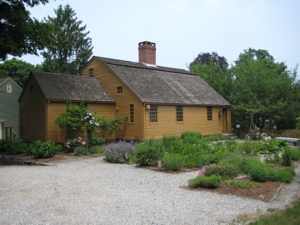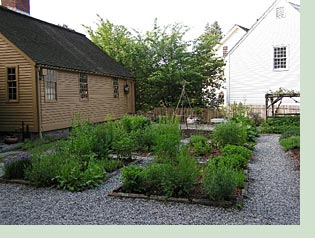Thankful Arnold House Garden
Thankful Arnold House Garden
Wilhelmina Ann Arnold Barnhart Memorial Garden
Haddam
June 14, 2008
 I visited this historic garden before the Historic Garden initiative began. As a result, I didn’t exactly spend too much time in the gardens, even though a lovely woman was tending to them during my visit to the house museum. I also didn’t take more than one picture of the garden (the one here to the left), so the other two garden pictures with the weird borders I don’t feel like fixing are from the Historic Gardens site.
I visited this historic garden before the Historic Garden initiative began. As a result, I didn’t exactly spend too much time in the gardens, even though a lovely woman was tending to them during my visit to the house museum. I also didn’t take more than one picture of the garden (the one here to the left), so the other two garden pictures with the weird borders I don’t feel like fixing are from the Historic Gardens site.
In my Thankful Arnold House visit write-up, I wrote:
The “Open” sign was displayed on the road, so I thought nothing of parking and approaching the museum. A very old woman who was gardening greeting me warmly. Then another woman appeared and acted as though she knew me. “Aha, CTMQ fans! Of course…” I thought to myself. Actually, no. They thought I was a new volunteer there to help out on the Open House Day. Darn.
Speaking of the garden, I’ll have you know that in 2000 the Connecticut Herb Study Group conducted extensive research to select plants commonly grown in household gardens in the lower Connecticut River Valley in about 1830. It was also recognized by the National Home Gardening Club and was featured in the summer 2003 issue of People, Places and Plants magazine. It’s a lovely garden.
 That was good enough for me at the time, but not anymore. A year after my visit, the Thankful Arnold House Museum was invited to join Connecticut’s Historic Gardens, a consortium of distinctive historic site and gardens throughout the Nutmeg State. Membership is by invitation only and just three sites were asked to join in 2009. (There are now 14).
That was good enough for me at the time, but not anymore. A year after my visit, the Thankful Arnold House Museum was invited to join Connecticut’s Historic Gardens, a consortium of distinctive historic site and gardens throughout the Nutmeg State. Membership is by invitation only and just three sites were asked to join in 2009. (There are now 14).
Now, I’d be silly to try to write about the garden in my own words. So I’ll let the fine folks responsible for it to do so:
Named after a direct descendent of Joseph and Thankful Arnold, the original garden was designed and dedicated in 1973. The garden was given in memory of Wilhelmina Ann Arnold Barnhart by her father Isaac Arnold, the benefactor of the Thankful Arnold House. The original garden design was created by Sally Marvin of Bloomfield, Connecticut and featured an orchard, berry beds and bench garden.
The gardens were redesigned in the late 1980′s in the Colonial Revival style with granite-edged beds and gravel paths. In 2000 the Connecticut Herb Study Group conducted extensive research to select plants commonly grown in household gardens in the lower Connecticut River Valley in about 1830. Most of the garden is now devoted to herbs used for cooking, medicine, dyeing, fragrance
and other household uses, with a small bed featuring vegetables common in gardens in the early 1800s and a few old-fashioned annuals. Over 50 varieties of herbs are planted in the garden, including many of the ones Thankful Arnold would have used in about 1830. Although Thankful’s garden would have been larger and simpler in design, the garden is an informative, pleasant, relaxing place for visitors.
The garden at the Arnold House is overseen by a handful of dedicated volunteers, who maintain it from early spring to late fall. The garden is open daily during daylight hours. A guided tour of the garden is available during museum hours and by appointment. Below is an excerpt from the Widow Arnold’s tour of the garden.
Right. The next couple paragraphs is supposed to be what The Widow Arnold (you can learn more about her on my museum page) would talk to us 21st century folks about when discussing her garden. I enjoy the creativity!
The Widow Arnold and Her Garden
“Now come out to the garden and I’ll show you some of the plants we grew and used. I didn’t have edged beds like you see here now, that style came after my time.. I had a big garden with plenty of vegetables to feed our family with useful herbs planted among
them. The gardens are planted now with herbs used in my time for cooking, medicine, dyeing, fragrance and household uses.
I grew a lot of root vegetables, like potatoes, turnips, onions and carrots, because they would keep through the winter in our cold cellar. By the end of that long winter you can believe we were ready for some green vegetables and that made this pot herb popular because it was one of the first to begin to grow. We called it All Good, I believe in your time it is called Good King Henry, but who ever heard of a ‘good king’? Sorrel is also an early green. We would usually cook them in soup and stews.”
Visit the Thankful Arnold House Museum to learn more about the Wilhelmina Ann Arnold Barnhart Memorial Garden
Back to CTMQ’s Gardens and Trees page
More on the Garden
Historic Gardens of CT






Leave a Comment